 Foreskin restoration is the process of expanding the residual skin on the penis, via surgical or non-surgical methods, to create the appearance of a natural foreskin (prepuce) covering the glans penis. Foreskin restoration techniques are most commonly undertaken by men who have been circumcised or who have sustained an injury, but are also used by uncircumcised men who desire a longer foreskin and by men who have phimosis.
Foreskin restoration is the process of expanding the residual skin on the penis, via surgical or non-surgical methods, to create the appearance of a natural foreskin (prepuce) covering the glans penis. Foreskin restoration techniques are most commonly undertaken by men who have been circumcised or who have sustained an injury, but are also used by uncircumcised men who desire a longer foreskin and by men who have phimosis.
Men attempt foreskin restoration for many reasons. These may range from simply wanting their foreskin back, to restoring a natural appearance, desire for improved sensitivity of the glans or better sexual stimulation, and regaining a sense of wholeness.1 Some men cite a desire to regain a sense of control over their sexual organs and regaining lost self esteem. Foreskin restoration may also be seen as a form of body modification for those interested.
Nonsurgical foreskin restoration, accomplished through tissue expansion, is the more commonly used method of foreskin restoration. Both the skin of the penile shaft and the mucosal inner lining of the foreskin, if any remains after circumcision, may be expanded.
The skin is pulled forward over the glans, and tension is applied manually, by using weights, or by using elastic straps. In the second two cases a device must be attached to the skin; surgical tape is often used. An example of a device using elastic straps is the T-Tape method, which was developed in the 1990s with the idea of enabling restoration to take place more rapidly. Many specialized foreskin restoration devices that grip the skin with or without tape are also commercially available. Tension from these devices may be applied by weights or elastic straps, by pushing the skin forward on the penis, or by a combination of these methods.
The amount of tension produced by any method must be adjusted to avoid causing injury, pain or discomfort, and may be seen as a limiting factor in foreskin restoration. There is a risk of damaging tissues from the use of excessive tension or applying tension for too long. Websites about foreskin restoration vary in their recommendations, from suggesting a regimen of moderate amounts of tension applied for several hours a day 2, to recommending periods of higher tension applied for only a few minutes per day. 3, 4
Tissue stretching has long been known to stimulate mitosis, and research shows that regenerated human tissues have the attributes of the original tissue. 5 Unlike conventional skin expansion techniques, however, the process of nonsurgical foreskin restoration may take several years to complete, and depends on the amount of skin available to expand, the amount of skin desired in the end, and the regimen of stretching methods used. Patience and dedication are needed; support groups exist to help with these (see External links section). The act of stretching the skin is often described informally as "tugging" in these groups, especially those on the internet.
1 Bigelow, Jim (1992). The Joy of Uncircumcising!: Exploring Circumcision: History, Myths, Psychology, Restoration, Sexual Pleasure, and Human Rights. Aptos, CA: Hourglass Book Publishing, 113-114
2 Greer, Donald M.; Mohl, Paul C.; Sheley, Kathy A. (1982). "A technique for foreskin reconstruction and some preliminary results". The Journal of Sex Research 18 (4): 324-30.
3 Foreskin Restoration Chat Manual Restoration Method and Guide
4 Manual Methods of Foreskin Restoration
5 Cordes, Stephanie; Calhoun, Karen H.; Quinn, Francis B. (1997-10-15). "Tissue Expanders". University of Texas Medical Branch Department of Otolaryngology Grand Rounds.


1 comment:
Good day please email me im interested in restoring. I am a filipino, too
Post a Comment